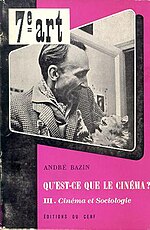This is an old revision of this page, as edited by Bbsrock (talk | contribs) at 04:08, 8 April 2006. The present address (URL) is a permanent link to this revision, which may differ significantly from the current revision.
Revision as of 04:08, 8 April 2006 by Bbsrock (talk | contribs)(diff) ← Previous revision | Latest revision (diff) | Newer revision → (diff)
André Bazin (April 18, 1918 – November 11, 1958) was a renowned and influential French film critic and film theorist.
Biography
Bazin was born in Angers, France, in 1918. He started to write about film in 1943 and was a co-founder of the film magazine Cahiers du cinéma in 1951, along with Jacques Doniol-Valcroze and Lo Duca. As a spiritual father of the Nouvelle Vague (French New Wave), he was also a mentor and personal friend to young film critics and filmmakers-to-be such as Jean-Luc Godard and François Truffaut. Bazin died of leukemia at the age of 40 in Nogent-sur-Marne, Île-de-France.
Film criticism
Bazin was a major force in post-World War II film studies and criticism. In addition to editing Cahiers until his death, a four-volume collection of his writings was published posthumously from 1958 to 1962 and titled Qu'est-ce que le cinéma? (What is Cinema?). Two of these volumes were translated into English in the late 1960s and 1970s and became mainstays of film courses in the US and England.
Bazin argued for films that depicted objective reality (such as documentaries and films of the Italian neorealism school) and directors who made themselves invisible (such as Howard Hawks). He advocated the use of deep focus (Orson Welles), wide shots (Jean Renoir) and the "shot-in-depth", and preferred what he referred to as "true continuity" through mise en scène over experiments in editing. This placed him in opposition to film theory of the 1920s and 1930s which emphasized how the cinema can manipulate reality.
The concentration on objective reality, deep focus, and lack of montage are linked to Bazin's belief that the interpretation of a film or scene should be left to the spectator.
Bazin believed that a film should represent a director's personal vision, which was rooted in the spiritual beliefs known as personalism. These ideas would have a pivotal importance on the development of the Auteur theory, which originated in an article by Truffaut in Cahiers.
Bazin also is known as a proponent of "appreciative criticism," wherein only critics who like a film can write a review of it, thus encouraging constructive criticism.
Bazin in pop culture
- Truffaut dedicated The 400 Blows to Bazin.
- Richard Linklater's film Waking Life features a discussion of Bazin's film theory. There is an emphasis on Bazin's Christianity and the belief that every shot is a presentation of God manifest.
Bibliography
In English:
- What Is Cinema?, by André Bazin (1967)
- Orson Welles, by André Bazin (1979)
- French Cinema of the Occupation and Resistance: The Birth of a Critical Esthetic, by André Bazin (1982)
- The Cinema of Cruelty: From Bunuel to Hitchcock, by André Bazin (1982)
- Essays on Chaplin, by André Bazin (1985)
- Jean Renoir, by André Bazin (1992)
- Bazin at Work: Major Essays & Reviews from the Forties and Fifties, by André Bazin, Bert Cardullo (ed.) (1996)
- French Cinema from the Liberation to the New Wave, 1945-1958, by André Bazin, Bert Cardullo (ed.) (2004)
In French:
- La politique des auteurs, edited by Andre Bazin. Interviews with Robert Bresson, Jean Renoir, Luis Buñuel, Howard Hawks, Alfred Hitchcock, Fritz Lang, Orson Welles, Michelangelo Antonioni, Carl Theodor Dreyer and Roberto Rossellini
- Qu'est-ce que le cinéma?, by André Bazin, originally published 1958-1962. New edition: Les Éditions du CERF, 2003.
External links
- André Bazin : An Unofficial Tribute to The World-Renowned Film Critic and Film Theorist
- André Bazin - Divining the real (page on BFI)
- André Bazin: Part 1, Film Style Theory in its Historical Context
- André Bazin: Part 2, Style as a Philosophical Idea
- André Bazin at IMDb